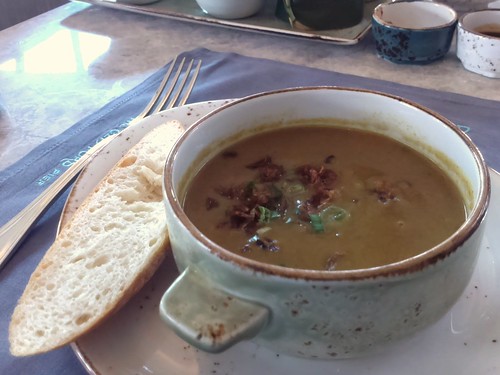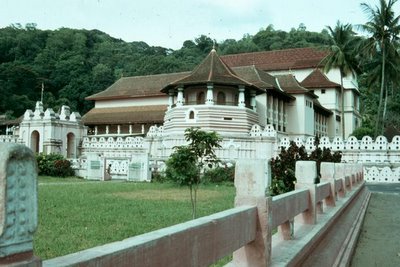Monasterboice in County Louth is home to the most spectacular high crosses in Ireland. The name Monasterboice derives from Mainistir Bhuithe (Buithe’s Monastery), as a monastery was thought to have been founded here by St. Buithe in the 6th Century. Over time this monastery flourished and grew in both size and prominence. Archaeologists studying aerial photography of the area, identified three concentric enclosures surrounding the core of the site, with the outer enclosure having a diameter of at least 600m (1968ft) enclosing a massive 24 hectares. Today all that is visible is the very heart of the monastery, with a fine round tower and three high crosses, one of which is arguably the finest high cross in Ireland.
 |
| The Round Tower |
Monasterboice is still used as a graveyard today, and there are good paths that lead the visitor through the site. As well as the early medieval high crosses and round tower, you can also see the remains of two small stone churches. These probably date to the late medieval period, and probably date to around the fifteenth century. Within one of the churches you can see a small bullaun stone. This stone with a circular hollow may have been used as a rudimentary holy water font during the early days of the monastery, or perhaps used as a large version of a mortar-and-pestle, maybe to grind herbs, ore for metallurgy, or pigments for manuscript illustration.
The round tower is a fine example, and stands at 28m (approximately 92ft) high. The iconic Irish Round Towers are thought to have been primarily constructed as bell towers as they are known as ‘cloigh teach’ in Irish Gaelic which translates to ‘bell house’. They would have also been visible from miles around, and as such they would have acted like a signpost to weary pilgrims on the route to Monasterboice. The round tower here was said to have housed the monasteries library and other treasures, unfortunately though it is recorded as being burned in 1097.
 |
| B&W Image of one of the churches with the tall West Cross on the right |
 |
| The path through the graveyard to the Round Tower |
South Cross (Muiredach’s Cross)
 |
| The Eastern Face of the South Cross |
The incredible South Cross is arguably the finest example of a high cross in Ireland. It probably dates to the early tenth century, as it is very similar to the West Cross at Clonmacnoise that was dated to c.904–916 AD. Like the Clonmacnoise example, the South Cross at Monasterboice also bears an inscription, asking for ‘a prayer for Muiredach’. It seems likely that this refers to Muiredach who died in 924 AD. He was the abbot of Monasterboice, and the vice-abbot of Armagh. He was also the chief steward of the powerful Southern Uí Néill dynasty, making him an incredibly important and influential figure in both religious and secular Ireland.
 |
| Depiction of The Last Judgement |
 |
| The Western Face of the South Cross |
My photographs cannot do the South Cross justice. It simply is one of the most important and visually stunning examples of early medieval sculpture in the world. The centrepiece of the crosshead on the eastern side is an amazing depiction of the Last Judgement. The largest figure in the centre is Christ with a phoenix representing the resurrection or perhaps the Holy Spirit, above him. Directly below you can see souls being weighed. To Jesus's right hand side (the left of the image) you can see the souls that have been saved, and nearest to Jesus you can see David playing his lyre. To the left hand side of Christ (on the right of the image) you can see the damned, the poor souls being driven into hell by a demon baring a trident.
The rest of the cross is taken up with biblical depictions. For example in this image you can see Moses standing with a staff and drawing water forth from the rock. The crowd of people are the thirsty Israelites. The image is a visual representation of the story in Numbers 20:7–13.
 |
| Moses (standing with staff) draws water from the rock |
 On the south facing side of the cross you can see this image of a snake eating its own tail while coiling around three human heads. Originally I thought that it could be a reference to the snake in the Garden of Eden, or perhaps some sort of warning of serpents dragging sinners to eternal damnation (to be fair the heads don’t look cheerful, and the poor chap in the middle looks like he was caught with a mouthful of crisps), however I was wrong. Thanks to the author of the excellent blog on Christianity in Early Medieval Ireland http://voxhiberionacum.wordpress.com I now know that the snake eating its own tail represents eternity and eternal life, and the heads are being lifted up towards God rather than plunging down into hell. It’s from John 3:14-15:
On the south facing side of the cross you can see this image of a snake eating its own tail while coiling around three human heads. Originally I thought that it could be a reference to the snake in the Garden of Eden, or perhaps some sort of warning of serpents dragging sinners to eternal damnation (to be fair the heads don’t look cheerful, and the poor chap in the middle looks like he was caught with a mouthful of crisps), however I was wrong. Thanks to the author of the excellent blog on Christianity in Early Medieval Ireland http://voxhiberionacum.wordpress.com I now know that the snake eating its own tail represents eternity and eternal life, and the heads are being lifted up towards God rather than plunging down into hell. It’s from John 3:14-15:“Just as Moses lifted up the snake in the wilderness, so the Son of Man must be lifted up, that everyone who believes may have eternal life in him.”
It’s a representation that can be found at a number of 9–10th century Irish high crosses, like the West Cross at Clonmacnoise for example.
 |
| Depiction of Adam and Eve on the left (note the serpent coiled around the tree) and Cain murdering Abel on the right |
Here's a guide to some of the imagery depicted on the eastern face of the cross:
The West Cross
 |
| The Eastern Face of the West Cross |
 |
| The Western Face of the West Cross |
The West Cross is the tallest High Cross in Ireland, standing at a massive 6.5m tall. Thanks to its size, it also has the largest number of figure sculpture panels of any High Cross. Like the South Cross these are also beautifully carved with depictions representing biblical stories from both the Old and New Testaments. You can see a great guide to the depictions on the National Museum of Ireland’s website here.  |
| Close up of the Western Face of the West Cross |
The North Cross
 |
| The North Cross |
You can find the North Cross within a small fenced area at the very northern boundary of the site, (as you first enter the site turn right and follow the path keeping the wall on your right hand side). It is much plainer than the South and West Crosses, though it is still worth a look as it has some lovely carvings. Next to it you can see an interesting [and rare] sundial, that would have marked the passing of time for the monks of Monasterboice indicating the canonical hours of 9am, 12pm and 3pm. In this small fenced area you can also see some other architectural fragments from the site.
 |
| The Sundial |
 We took a trip to Monasterboice on a beautiful crisp morning on the 11th January 2014 and found it to be a wonderfully rewarding place to visit. The site is well signposted off the M1, around 8km north-west of Drogheda in County Louth. After your visit I recommend a short 10min drive to Mellifont Abbey, another beautiful site situated very close by. While you’re in the area if you enjoyed the stunning early medieval high crosses why not take a short spin down to Kells in County Meath, where you can find more fantastic examples of early medieval high crosses. We have a FREE audioguide to Kells full of facts, stories, legends and history. To download your free MP3 please visit Abarta Heritage or to download a free audio-visual app for Apple or Android visit here https://www.guidigo.com/A6QzbS7ImVo
We took a trip to Monasterboice on a beautiful crisp morning on the 11th January 2014 and found it to be a wonderfully rewarding place to visit. The site is well signposted off the M1, around 8km north-west of Drogheda in County Louth. After your visit I recommend a short 10min drive to Mellifont Abbey, another beautiful site situated very close by. While you’re in the area if you enjoyed the stunning early medieval high crosses why not take a short spin down to Kells in County Meath, where you can find more fantastic examples of early medieval high crosses. We have a FREE audioguide to Kells full of facts, stories, legends and history. To download your free MP3 please visit Abarta Heritage or to download a free audio-visual app for Apple or Android visit here https://www.guidigo.com/A6QzbS7ImVo
This is our first blogpost of 2014. We have so many more of Ireland’s fantastic heritage sites to share with you that I hope to up our output to one or two blogposts a week if possible. I’m planning on tweaking the blog a little so if you have any suggestions of key information you’d like me to include please do drop me a line to info@abartaaudioguides.com or feel free to leave a comment below. I’d really value your input.
As a new addition here is a table with some key information:
If you’d like to keep up with daily images and information about Ireland’s fantastic heritage sites please consider following Neil’s company Abarta Audioguides on Facebook, Twitter, Instagram or Google+.
If you’d like to support us please consider downloading an audioguide from abartaheritage.ie: they are packed with great facts, information, stories and legends from Ireland’s iconic sites. They are designed to be fun and informative whether you are visiting the sites or from the comfort of your own home, so if you are looking to escape to the Court of Brian Boru the next time you are doing household chores, download one of our guides and let Abarta whisk you off to ancient Ireland!
All images © Neil Jackman/Abarta Heritage
Some Sources and Recommended Reading:
Edwards, N. 2002. The Archaeology of Early Medieval Ireland. (Routledge, London)
Hamlin, A. and Hughes, K. 1997. The Modern Traveller to the Early Irish Church. (Four Courts Press, Dublin)
Ó Carragáin, T. 2010. Churches in Early Medieval Ireland. (Yale, Singapore).
Ó Cróinín, D. (ed) 2005. A New History of Ireland, Prehistoric and Early Ireland (Oxford University Press, New York).
















































